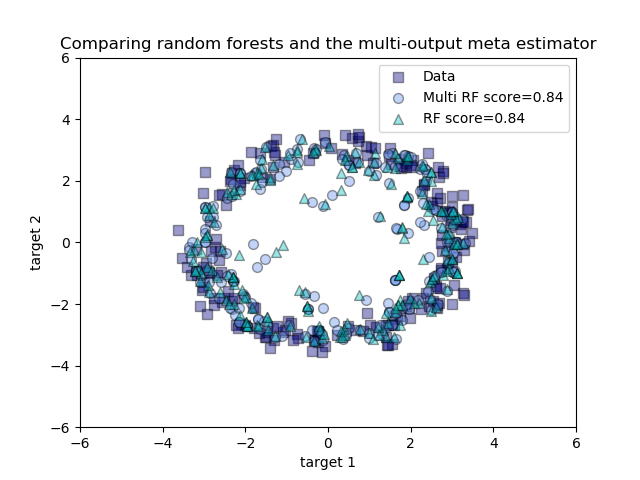sklearn.multioutput.MultiOutputRegressor?
class sklearn.multioutput.MultiOutputRegressor(estimator, *, n_jobs=None)
[源碼]
多目標回歸
該策略包括為每個目標安裝一個回歸器。這是擴展本來不支持多目標回歸的回歸變量的簡單策略。
版本0.18中的新功能。
| 參數 | 說明 |
|---|---|
| estimator | estimator object 實現擬合和預測的估計對象。 |
| n_jobs | int or None, optional (default=None) 為并行運行的作業數 fit。 None除非在joblib.parallel_backend上下文中,否則表示1 。 -1表示使用所有處理器。有關 更多詳細信息,請參見詞匯表。當各個估算器快速訓練或預測使用 n_jobs>1時,由于生成過程的開銷而導致性能降低。v0.20版中的更改: n_jobs默認從1更改為None |
| 屬性 | 說明 |
|---|---|
| estimators_ | list of n_output estimators用于預測的估計量。 |
實例
>>> import numpy as np
>>> from sklearn.datasets import load_linnerud
>>> from sklearn.multioutput import MultiOutputRegressor
>>> from sklearn.linear_model import Ridge
>>> X, y = load_linnerud(return_X_y=True)
>>> clf = MultiOutputRegressor(Ridge(random_state=123)).fit(X, y)
>>> clf.predict(X[[0]])
array([[176..., 35..., 57...]])
| 方法 | 說明 |
|---|---|
fit(X, y[, sample_weight]) |
使模型擬合數據。 |
get_params([deep]) |
獲取此估計量的參數。 |
partial_fit(X, y[, sample_weight]) |
使模型逐漸擬合數據。 |
predict(X) |
使用模型預測多輸出變量 |
score(X, y[, sample_weight]) |
返回預測的確定系數R ^ 2。 |
set_params(**params) |
設置此估算量的參數。 |
__init__(estimator, *, n_jobs=None)
[源碼]
初始化self, 請參閱help(type(self))以獲得準確的說明。
fit(X, y, sample_weight=None, **fit_params)
[源碼]
使模型擬合數據。為每個輸出變量擬合一個單獨的模型。
| 參數 | 說明 |
|---|---|
| X | (sparse) array-like, shape (n_samples, n_features) 數據。 |
| y | (sparse) array-like, shape (n_samples, n_outputs) 多輸出目標。指標矩陣可打開多標簽估計。 |
| sample_weight | array-like of shape (n_samples,), default=None 樣本權重。如果為None,則對樣本進行平均加權。僅當基礎回歸變量支持樣本權重時才支持。 |
| **fit_params | dict of string -> object 參數傳遞給 estimator.fit每個步驟的方法。 |
| 返回值 | 說明 |
|---|---|
| self | object |
get_params(deep=True)
[源碼]
獲取此估計量的參數。
| 參數 | 說明 |
|---|---|
| deep | bool, default=True 如果為True,則將返回此估算器和作為估算器的所包含子對象的參數。 |
| 返回值 | 說明 |
|---|---|
| params | mapping of string to any 參數名稱映射到其值。 |
partial_fit(X, y, sample_weight=None)
[源碼]
使模型逐漸擬合數據。為每個輸出變量擬合一個單獨的模型。
| 參數 | 說明 |
|---|---|
| X | (sparse) array-like, shape (n_samples, n_features) 數據。 |
| y | (sparse) array-like, shape (n_samples, n_outputs) 多輸出目標。 |
| sample_weight | array-like of shape (n_samples,), default=None 樣本權重。如果為None,則對樣本進行平均加權。僅當基礎回歸變量支持樣本權重時才支持。 |
| 返回值 | 說明 |
|---|---|
| self | object |
predict(X)
[源碼]
使用模型預測多輸出變量
? 針對每個目標變量進行訓練。
| 參數 | 說明 |
|---|---|
| X | (sparse) array-like, shape (n_samples, n_features) 數據。 |
| 返回值 | 說明 |
|---|---|
| y | (sparse) array-like, shape (n_samples, n_outputs) 跨多個預測變量預測的多輸出目標。注意:為每個預測變量生成單獨的模型。 |
score(X, y, sample_weight=None)
[源碼]
返回預測的確定系數R ^ 2。
系數R ^ 2定義為(1- u / v),其中u是平方的殘差和((y_true - y_pred) ** 2).sum(),而v是平方的總和 ((y_true - y_true.mean()) ** 2).sum(). 。可能的最高分是1.0,并且可能為負(因為該模型可能會更差)。不管輸入特征如何,始終預測y的期望值的恒定模型將獲得0.0的R ^ 2分數。
| 參數 | 說明 |
|---|---|
| X | array-like of shape (n_samples, n_features) 測試樣本。對于某些估計量,這可能是一個預先計算的核矩陣或泛型對象列表,shape=(n_samples,n_samples_fitted),其中n_samples_fitted是在擬合估計器時使用的樣本數。 |
| y | array-like of shape (n_samples,) or (n_samples, n_outputs) X的真實值。 |
| sample_weight | array-like of shape (n_samples,), default=None 樣本權重 |
| 返回值 | 說明 |
|---|---|
| score | float self.predict(X) wrt. y.的R^2 |
注
調用score回歸器時使用的R2得分multioutput='uniform_average'從0.23版開始使用 ,r2_score已與默認值保持一致。這會影響score所有多輸出回歸變量的方法(除外 MultiOutputRegressor)。
set_params(**params)
[源碼]
設置此估算器的參數。
該方法適用于簡單的估計器以及嵌套對象(例如 pipelines)。后者具有形式的參數, <component>__<parameter>以便可以更新嵌套對象的每個組件。
| 參數 | 說明 |
|---|---|
| **params | dict 估算量參數。 |
| 返回值 | 說明 |
|---|---|
| self | object 估算量實例。 |

